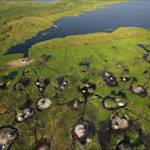The Camargue
2023 CE • Southern France
"Covering an area of over 930 square kilometres, Western Europe’s largest river delta is an immense plain with a series of briny étangs (lagoons) encircled by reeds and marshland, or separated from the sea by sandbars. It lies between the Mediterranean and the two arms of the Rhône River delta – the Grand Rhône to the east, and the Petit Rhône to the west. Humans have lived here since early times, altering the landscape with drainage schemes, paddy fields and salt pans. To the north the land was drained for agricultural purposes, and cereals, rice and vines are grown . . . Around one third, however, is still lagoon or marshland – some of the most natural and most protected land in Europe . . . Today the Camargue is home to more than 400 bird species, and its saline ponds provide an ideal habitat – one of the few in Europe – for the greater flamingo. Other wetland birds include white stork, herons, bitterns, glossy ibis, terns and shorebirds such as black-winged stilt . . . The native flora has adapted to the salty conditions: sea lavender and glasswort flourish, along with tamarisks and reeds. The marshes are a prime habitat for many species of insects, especially the ferocious mosquitos found here. Semi-wild white Camarguais horses roam the marshlands . . . The region’s geography is in constant flux as the Rhône carries huge quantities of silt downstream. Some lagoons were former branches of the river that have now stopped flowing, and the coastline is pushed outwards by silt deposited at the river mouths. Although these changes have been slowed in recent years by specialised construction, flooding remains a major problem." The fragile ecosystem of the Camargue is facing a growing threat from the effects of climate change. As sea levels rise, wetlands are being encroached upon and saltwater is infiltrating the ecosystem at an increasing rate. Meanwhile, rising temperatures are exacerbating heatwaves and drought, which in turn are reducing the freshwater that many of the area's wildlife species rely on for survival.
Quote: "The Camargue," Wildlife Worldwide.
Josephine Joly, "Camargue: Why is France's natural wildlife paradise threatened by climate change?," Euronews.Green, November 22, 2021.
Image: Clément Bardot, CC BY-SA 4.0, via Wikimedia Commons


Learn about Maya Lin’s fifth and final memorial: a multi-platform science based artwork that presents an ecological history of our world - past, present, and future.

Discover ecological histories and stories of former abundance, loss, and recovery on the map of memory.

Learn how we can reduce our emissions and protect and restore species and habitats – around the world.

See how art can help us rethink the problems we face, and give us hope that each one of us can make a difference.

Help make a global memorial something personal and close to home. Share your stories of the natural world.


